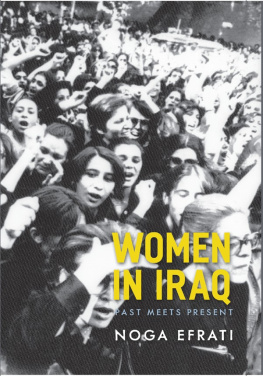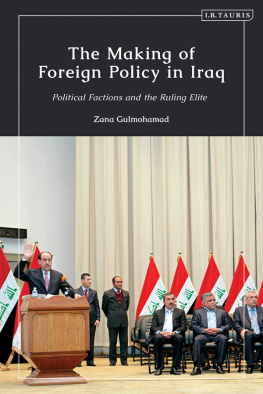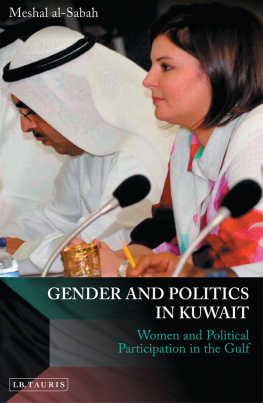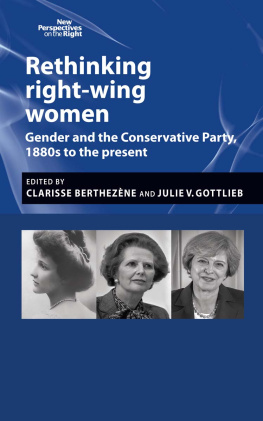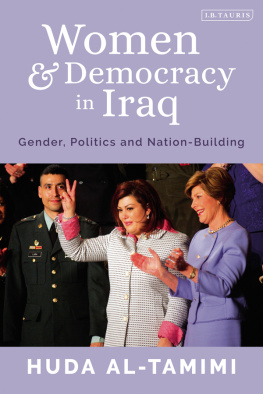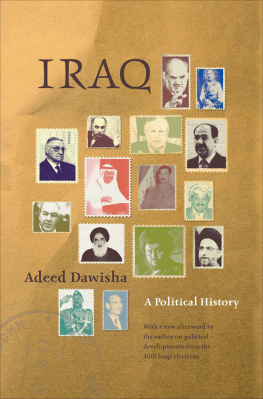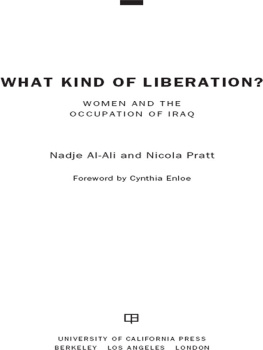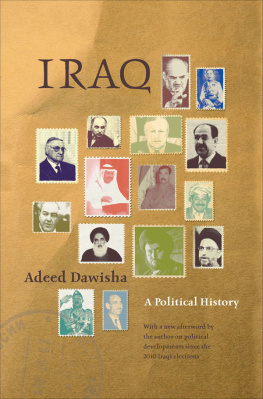COLUMBIA UNIVERSITY PRESS
Publishers Since 1893
NEW YORK CHICHESTER, WEST SUSSEX
CUP.COLUMBIA.EDU
COPYRIGHT 2012 COLUMBIA UNIVERSITY PRESS
ALL RIGHTS RESERVED
E-ISBN 978-0-231-53024-8
LIBRARY OF CONGRESS CATALOGING-IN-PUBLICATION DATA
EFRATI, NOGA.
WOMEN IN IRAQ : PAST MEETS PRESENT / NOGA EFRATI.
P. CM.
INCLUDES BIBLIOGRAPHICAL REFERENCES AND INDEX.
ISBN 978-0-231-15814-5 (CLOTH : ALK. PAPER) ISBN 978-0-231-53024-8 (EBOOK)
1. WOMENIRAQSOCIAL CONDITIONS. 2. FEMINISMIRAQHISTORY.
3. WOMENS RIGHTSIRAQHISTORY. I. TITLE.
HQ1735.E47 2012
305.4209567DC23
2011022457
A COLUMBIA UNIVERSITY PRESS E-BOOK.
CUP WOULD BE PLEASED TO HEAR ABOUT YOUR READING EXPERIENCE WITH THIS E-BOOK AT .
REFERENCES TO INTERNET WEB SITES (URLs) WERE ACCURATE AT THE TIME OF WRITING. NEITHER THE AUTHOR NOR COLUMBIA UNIVERSITY PRESS IS RESPONSIBLE FOR URLs THAT MAY HAVE EXPIRED OR CHANGED SINCE THE MANUSCRIPT WAS PREPARED.
DESIGN by VIN DANG
Saddam Husains downfall raised the hopes of many Iraqi women for a better future. The U.S.-led invasion of their country in March 2003 had been accompanied by a promise to improve their lives: the George W. Bush administration in particular had pledged to turn Iraq into a free and democratic country in which womens rights are enshrined as a model for the whole region. Galvanized by this fresh sense of freedom, a multitude of womens associations appeared countrywide, representing all segments of Iraqi society.
Early on, however, obstacles appeared as womens political participation in the new Iraq became an issue of contention. Only three of twenty-five seats on the U.S.-appointed interim Iraqi Governing Council in July 2003 went to women, and only one woman minister was selected for the provisional government set up immediately afterward. Then, in December 2003, a resounding wake-up call was delivered: the council announced it was abolishing Iraqs Personal Status Lawthe family law that had included many provisions favorable to women. Furthermore, under the mounting disorder, tribal courts were convened, and coalition forces, faced with the urgent need to reestablish order across the southern part of the country, gave a nod to tribal law that sanctioned coercive practices pertaining to women. As the invasion turned into full-scale occupation, it became increasingly clear that any promise by the allies to support womens rights was far from realization.
Beyond the crumbling infrastructure and general lack of security, an increase in gender-based violence gravely concerned activists. If anything, developments were pulling women back to the past, they cautioned. It was not only the memory of life under Saddams regime that fanned their fears. They were haunted, too, by ghosts of a more distant history. A foreign occupation with the declared intent of building a liberal state was not a new notion in their country. Indeed, the British invasion and occupation of Mesopotamia had led to the inception of the Iraqi state in the wake of World War I and determined its structure for years to come. Activists often alluded to this attempt at state building and its harsh long-lasting consequences for women.
Unfortunately, however, most observers and, more important, decision makers failed to appreciate the weight of these warnings. Activists did not often elaborate on this untold history of women in Iraq, and even as scholars began revisiting the period of direct British rule and the British Mandate era in Iraq, their works offered little illumination. In fact, historical studies of womens issues have only rarely extended beyond the Bath period (19682003). This book contributes to filling this historiographical lacuna and elucidates activists fears springing from the period of the British occupation and the British-backed monarchy (19171958).
Looking back to the monarchy period and beyond enhances our understanding of activists post-2003 struggle to secure meaningful participation in politics for women, to preserve Iraqs progressive Personal Status Law, and to prevent state acknowledgment of customary law and coercive practices pertaining to women. The pages of history shed light on the struggle from a different perspective as well. Conservative and religious politicians attempting to delegitimize activists struggle accused activists of unauthenticity and of being detached from Iraqs traditions and past. I demonstrate here, however, that the roots of activists struggle against coercive customs, unfavorable interpretations of Islamic law, and exclusion from the political sphere reach back to the birth of the state.
This volume is first and foremost a historical work. It is a part of a rapidly growing research fieldthe study of women and gender in the Middle East. This field has come into its own over the past thirty years:
Meriwether and Tucker identify four approaches. The first is the study of women worthiesthat is, notable women who in the past played a visible role in public activities. This approach includes biographical studies of famous women or a vivid recounting of known historical events that highlights the hitherto unknown (or underappreciated) role played by individual women. The second approach encompasses the study of political and institutional history. It looks at the activities of women in political movements, whether feminist or nationalist or both. Some of the works characterizing this approach were written in an institutional history style that reconstructs the events, leadership, and activities of the subject organization while allowing us to follow the evolution of feminist thought as it developed in practice. Tucker and Meriwether note that applying these two approaches opens a new angle of discussion regarding issues such as the nature of political power and the location of political activities. However, these approaches generally seek to add women, mainly women of the elite, to the pages of history and not to challenge the fundamental bases of history writing.
The remaining two approaches take up this challenge. The study of women in the social and economic history of the Middle East also seeks to add women to history, but as part of an extended picture of the past that exceeds the boundaries of political history or the study of elites. It looks at women as economic actors and as active members of their communities, families, and classes. The final approach centers on women in the cultural history of the Middle East. Tucker and Meriwether emphasize the study of dominant and contesting gender discourses within this framework. The discourse on gender, they explain, attends to the ways in which the dominant culture in a particular place and time has defined maleness and femaleness as points of difference or opposition, with the male always in the position of power and domination. Although it seeks to understand how male-privileged discourses evolved, it also endeavors to bring subversive discoursesthat is, the ways in which people endeavor to undermine and contest the discourse of powerto the forefront.
Meriwether and Tuckers categorization is helpful, but it is also problematic in that many of the groundbreaking studies they mention can be placed in more than one category. This problem is due mainly to the fact that most historians they survey published their works in the 1990s and were aware of these different approaches and their limitations. These historians did not hesitate, therefore, to combine different methods in their effort to provide the most comprehensive picture on the subject of their research. Leila Ahmeds

